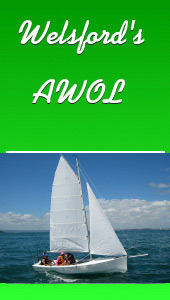
 Custom Search
|
| sails |
| plans |
| epoxy |
| rope/line |
| hardware |
| canoe/kayak |
| sailmaking |
| materials |
| models |
| media |
| tools |
| gear |
| join |
| home |
| indexes |
| classifieds |
| calendar |
| archives |
| about |
| links |
| Join Duckworks Get free newsletter CLICK HERE |
|
|
| The Lesson of the Lymington Scow |
by Michael Storer - Adelaide, South Australia - Australia |
| Brian rolled up on my forum because he could see we were being serious about improving the efficiency and performance of the balance lug rig – a kindred spirit. He races (among other things) in the Lymington Scow class which is rigged with a balance lug mainsail. Some boats are raced singlehanded with mainsail only and others are sloop rigged. It is an excellent low cost class and provides very tight racing because the speed differences between boats are restricted by length.
I was completely unaware of them but when Brian mentioned they were built by John Claridge (several times world champion as well as builder and designer in the ultra competitive Moth class).
Remember what I said about boats improving fast when there is regular racing … well … the scow has been a racing class since 1905 and Brian has been one of the sailors with runs on the board. They have learned a thing or two. Remember, I said that modern boats have powerful boom vangs/kickers? Well, the Lymington Scows do too. They have a setup that was quickly fitted to this Goat Island Skiff.
The sailors that used it found it effective and powerful. It also allowed some interesting (some would say strange options) of moving the boom backwards and forwards relative to the mast for steering balance upwind (a couple of degrees of weather helm in the tiller please) and on a run downwind the sail could be centred with more equal areas either side of the mast.
I was lucky enough to go sailing on Bruce’s (woodeneye on my forum) Goat one the central Coast of NSW. Powerful, but I didn’t like the expense of two vang systems and also I thought it was too finicky for average sailors. If you wanted to reduce the tension in the after vang you had to take up some of the slack in the forward vang. Also it was easy to lose where the boom should actually be because it is all floating around – to confusing except for the experts and frustrating for some would be experts (me). The Lymington scow avoids some of this complication as the boom is carried with the forward end adjacent the mast – see the photo of a section of their fleet up the page. It was also getting away from the simplicity of the Goat Island Skiff. The boat in standard form has a total of 5 or 6 blocks (pulleys) and it is a fast boat without all the stuff. So was there a way to get the same effect with something like the original gear? The original gear can do this - at the Small reach regatta and more complex gear doesn’t change this much. Enter the Vanghaul and Bleater (it is a GOAT) – a gentleperson’s approach to Balance Lug efficiency. So the criteria have changed or become better defined. 1. We want to control twist better One of the other changes of the previous year or two contributed. Many builders had decided to change over to a loose footed mainsail and get rid of the lacing along the foot. This is very good for sail power, but the result is that the existing downhaul and the square lashing used to hold the boom against the mast can easily slip forward or back if not fully tensioned. The double vang photos above show a loose footed sail - no lacing along the boom so you can adjust the sail depth more easily. The other change that had led to was experimentation in the boom stiffness and dimensions as the standard boom in the plans only works with a laced foot – this is a snapshot – you can see the complete data on the WIKI:
In a couple of days discussion on the Goat Island Skiff forum we worked out a new combination. One of the sailors was having a small problem when rigging – the boom would swing forward and get caught under the gunwale. The original square lashing wasn’t cutting it – particularly when a loose foot arrangement was used on the boom. The square lashing …
So he had tied a rope to the front end of the boom and then to the mast. We decided to call it a bleeater … well, they are Goats. I’ve seen it set up that way before. The middle one is a direct corollary of the halyard system we use but not adjustable. This illustration below shows the original square lashing compared with the bleeter (bleater).
The “strong version” holds the boom to the mast with much more force and can cause binding on square masts. The Moderate version still has the tension vector pulling the boom up close to the mast providing the boom is always pulled forward. So here we introduce the vanghaul – a mixture of boom vang /kickerand downhaul which works nicely in conjunction with the bleeter. The really exciting thing to me is it is EXACTLY the same setup as the original but with the rope and downhaul redeployed. A really nice solution. Not everyone likes it though – if the bleeter tends to bind and restricts the boom from rotating around the mast you will have to use the moderate version. Some still don’t like it, some really like it.
Then the comparison of the original, the two vang and the bleeter/vanghaul system in this diagram.
Top section is the system in the plan and the general lug setup for all the storerboats. It is simple and effective. Mid section is the two vang system from the Boy racers will still really like this system with it’s infinite adjustment and ability to throw the rig around relative to the mast. It allows the widest range of options but at the risk of some complication, a little extra expense and also a need for the knowhow to feel what the boat is doing and to put the sail in the place you want. The bottom illustration is the Bleeter (green) with Vanghaul (purple). One important note is that the power of the vanging is proportional to the distance between the tack of the sail (forward bottom corner) and the vanghaul. So the comparison with the conventional rig is shown to the right. The distances should be about the same from the tack of the sail - not the mast as we were tempted to think. If you have the vanghaul too far back from the mast you lose luff tension in the sail, very bad for pointing upwind. So for Goat sized boats we have found the vanghaul should be attached to the boom about 4 or maybe 6 inches (100 to 150mm) behind the mast as a starting point. Sailing is the final test for the correct position of course. Like I said, not everyone likes it, but some certainly do. And it uses the existing gear and means that you have a good excuse to update a puny downhaul. |
|












